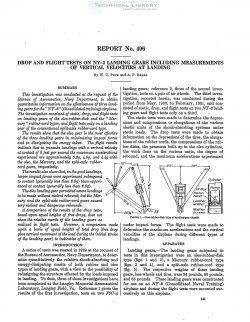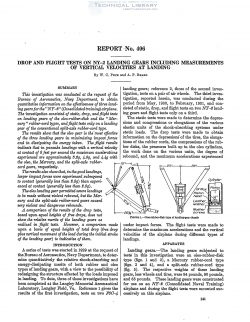naca-report-406

- Version
- 174 Downloads
- 1.13 MB File Size
- 1 File Count
- August 26, 2016 Create Date
- August 26, 2016 Last Updated
National Advisory Committee for Aeronautics, Report - Drop and Flight Tests on NY-2 Landing Gears Including Measurements of Vertical Velocities at Landing

This investigation was conducted at the request of the
Bureau of Aeronautics, Navy Department, to obtain
quantitative information on the efl'ectiveness of three land-
ing gears for the ” -2” (Consolidated training) airplane.
The investigation consisted of static, drop, and flight tests
on landing gears of the oleo-rubber-disk and the “Mer-
cury” rubber-cord types, and flight tests only on a landing
gear of the conventional split—axle rubber-cord type.
The results show that the oleo gear is the'most efective
of the three landing gears in minimizing impact forces
and in dissipating the energy taken. The flight results
indicate that in pancake landings with a vertical velocity
at contact of 8 feet per second the maximum accelerations
experienced are approximately 32g, 4.9g, and 4.4g with
the oleo, the Mercury, and the split-asle rubber-
cord gears, respectively.
The results also show that, in the good landings,
larger impact forces were nperieiwed subsequent
to contact (generally less than 2.89) than empori-
enced at contact (generally less than 2.0g).
The oleo landing gear permitted severe landings
to be made without violent rebound, but the Mer-
cury and the split—axle rubber-cord gears caused
very violent and dangerous rebounds.
A comparison of the results of the drop tests,
based upon equal heights of free drops, does not
show the relative merits of the landing gears as
realized in flight tests. However, a comparison made
upon a basis of equal heights of total drop (free drop
plus vertical movement of the load during the initial stroke
of the landing gear) is indicative of them.
A series of tests was started in 1929 at the request of
the Bureau of Aeronautics, Navy Department, to deter-
mine quantitatively the relative shock-absorbing and
energy-dissipating merits of both rubber and oleo
types of landing gears, with a view to the possibility of
redesigning the structure afiected by the loads imposed
in landing.
| File | Action |
|---|---|
| naca-report-406 Drop and Flight Tests on NY-2 Landing Gears Including Measurements of Vertical Velocities at Landing.pdf | Download |

Comment On This Post